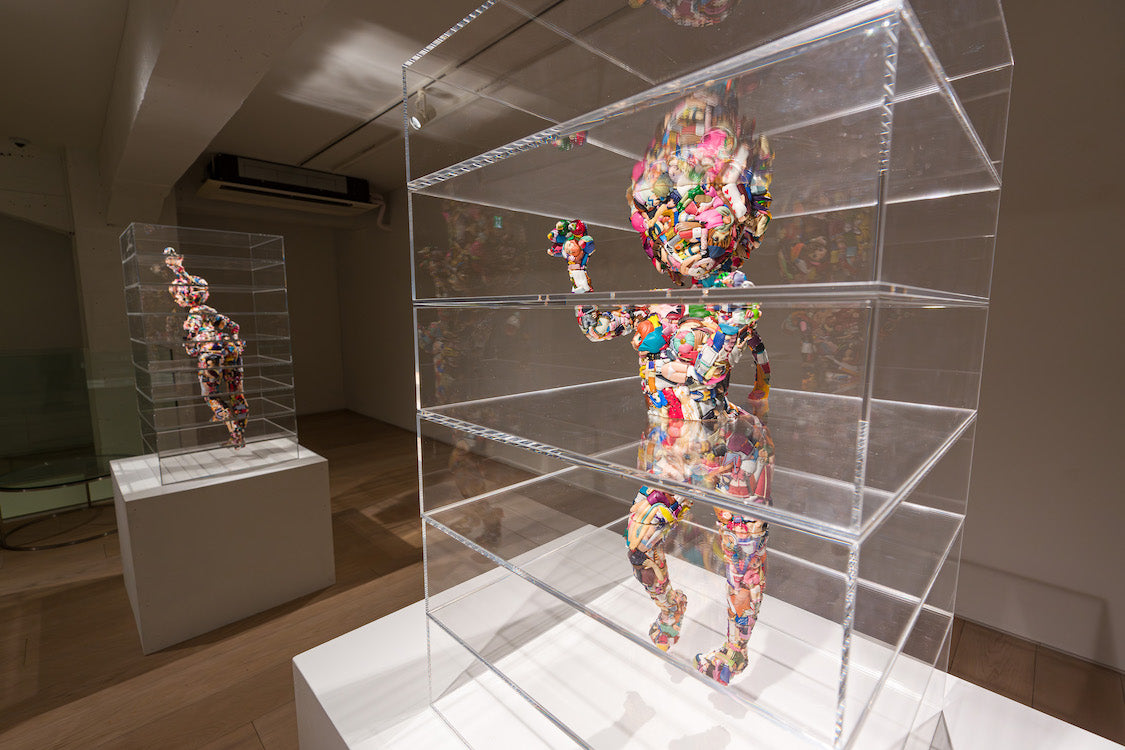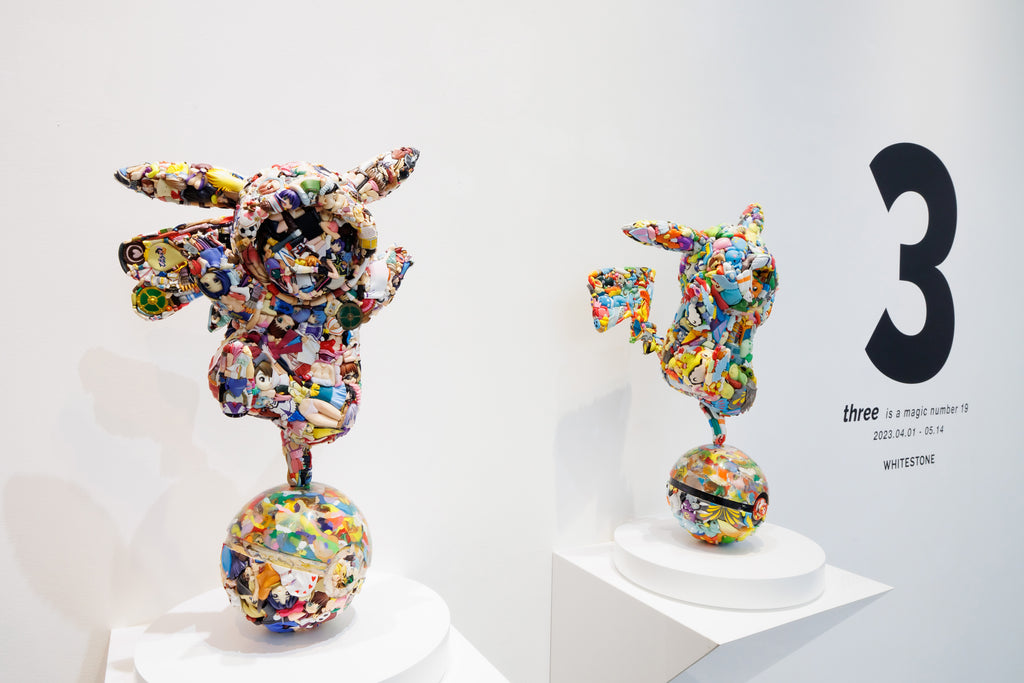ARTICLES
Disassembly, Dissolution, and Reconstruction | Fragmented Figures and Identity
2024.03.05
FEATURE

『three: three is a magic number 21』Whitestone Ginza New Gallery, 2024
"three" is a three-member artist unit known for their colorful, three-dimensional artworks that resemble sculptures and electronic devices. A closer look at their artworks reveals that their surfaces are tightly packed with the faces, limbs, and clothing of anime figures. What made them decide to use novelty figurines circulating on the market as a material for their works? We visited three's art studio in Fukushima to explore the themes of their art as well as their creative methods, unraveling it through the words of one of their members, Hiroki Kawasaki.
The Fascinating Ephemerality of Fragmentation
three《6309g》 2024, 50.0×90.0×50.0cm, Figure, Acrylic box.
The artwork creation of three begins from fragmentation, i.e. the disassembly of a large number of plastic figures. These figures are usually sold as capsule toys, with their individual parts separated inside the capsule. After opening the capsule, the parts are fitted together to assemble the figure. From here, three disassembles them again to separate the parts they need for their artwork. They take the heads and other important parts that embody the characters the most, using it as a material for the artwork surface. The remaining parts are cut up into small pieces, reverting them into rudimentary materials.

Faces are the parts that express the characters’ personalities the most, and they are usually used prominently on the artwork’s surfaces.
“Showing the whole character can be interesting, but by showing only a single, independent fragment, we want to give a glimpse into a powerful expression through our artworks, similar to a manga panel that shows only someone's face or eyes, or a movie scene that focuses on a specific body part."

Individuality Formed through Fragmentation and Aggregation
Using a heat gun to melt a figure's face
Through the process of disassembling individual figures, melting them, and reconstructing them into a single artwork, three alludes to the relationship between the individual and society. While the characters that appear in anime, manga, and movies are unique and original, they get replicated many hundreds, even thousands of times into figures that are sold all over the world.

At the art studio of three
On the other hand, three is also known for making art installations that use countless numbers of fish-shaped plastic soy sauce containers. These works express the assembly of the masses into a single structure, a complete opposite to the aggregation expressed in the artworks made from figures.

three 《Tokyo I/O》 2019, 1,318 × 477 × 300 cm, fish-shaped soy sauce container, water, ink, wood.
This bidirectional transition from the individual to the masses, and from the masses to the individual, is an important factor in shaping every person's identity. Whether it's a fragment of culture, ideology, history, or society, Kawasaki believes that everything we learn, absorb, and experience throughout our lives melts together and forms an amalgamation of our current identity.

Sculpture prototypes made from clay. Similar to the actual manufacturing process for figures, three also makes artworks by sculpting prototypes, creating plaster molds, then filling the molds with the disjointed parts of figures.
The Beauty of Cutting through Melded Materials
three《6309g》2024, 50.0×90.0×50.0cm, Figure, Acrylic box.
three's methods of artistic expression are wide and varied. Among their artworks that use figures, some are flat works like paintings, some are three-dimensional sculptures, while others make use of actual devices such as TV screens and video game consoles.
For their exhibition entitled "three is a magic number 21" at the Whitestone Ginza New Gallery, they took on the challenge of creating single artworks that incorporate both sculpture molding and cutting. Many of their works feature cross-sections that reveal a marbled surface of melted figure parts, boldly displaying their prolific use of figures as an artistic material.
『three: three is a magic number 21』Whitestone Ginza New Gallery, 2024
three has created artworks that are cut in different ways, but for this exhibition, they are exhibiting works that feature horizontal cross-sections, a method of cutting that they find especially attractive. One example is the work entitled "6309g", which has a shape resembling a bunny girl character. It is sectioned into nine different layers, each enclosed in a transparent acrylic box. Though the general shape of the character is maintained, the acrylic boxes can be stacked irregularly, giving it an unsettling three-dimensional form.
The Reason Behind the Use of Countless Figures

At the art studio of three
What got three started in using figures for their artworks was a submission for a public exhibition held not long after they began working as a unit. They began by studying the use of figures as an art material, going through a process of trial-and-error before arriving at their current artistic method.
"All the colors of the marble-like texture are from the colors of the characters we use. The surface paint of the figures ultimately forms the colors of the marble pattern, and this process removes the identity of each character as they gradually revert to simply being colors. We found this aspect fascinating, so we decided to create artworks that made use of many different melted figures."

『three: three is a magic number 21』Whitestone Ginza New Gallery, 2024
What started as the process of melting a single figure evolved into melting several different figures together, leading them to create artworks with larger scales which also took on various themes.
"Just like the Internet, where the different thoughts and ideas of various people all blend together in a single platform, our idea was to create an artwork that embodied a conglomeration of various characters of different origins."
Humans and Materials: The Individual and the Whole

three member Hiroki Kawasaki at their studio
During the interview at three's studio in Fukushima, Kawasaki states that by exhibiting many artworks that make abundant use of familiar objects as a material, he wants viewers to feel the indescribable power and pressure created when a vast number of things come together as one.
Through their artworks that make use of figures as a material, three seeks to vividly express the process of reconstructing fragmented identities, and explore the complex relationship between the individual and the masses. Experience their works and visualize their powerful message of individual elements fusing together into a single entity to give birth to a new form.




